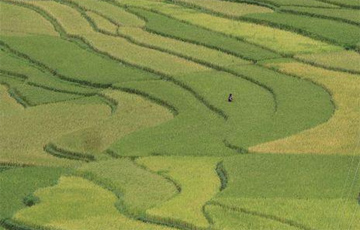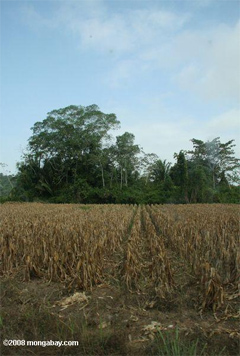Prehistoric farmers may have changed climate: controversial theory gaining ground
Did prehistoric farmers drive early global warming?
Jeremy Hance, mongabay.com
September 3, 2008
|
|
In 2003 William Ruddiman put forth a controversial theory: 7,000 years ago the rise of agriculture spawned large-scale climatic changes. According to Ruddiman, the felling of forests for fields throughout Europe and Asia caused a rise in carbon dioxide, while the flooded fields for rice released methane gas. This combination of large amounts of carbon dioxide and methane entering the atmosphere caused the globe to warm, preventing the planet from entering another ice age.
Re-examining Ruddiman’s theory, an article in New Scientist states that when the theory was first proposed “there was no shortage of criticism”; however since then, Ruddiman has been able to answer a fair number of critics with further research and more evidence.

|
Climatologists agree that approximately 7,000 years ago carbon levels took an unexpected turn. For 400,000 years carbon and methane in the atmosphere followed a pattern dependent on predictable changes in earth’s axis and orbit. Then 7,000 years ago—following the Neolithic Revolution’s spread across Europe and Asia—atmospheric carbon went up instead of going down as was expected from the established pattern. Many scientists believe this unexpected twist must be connected to some natural occurrence, but Ruddiman argues climate change has been due to humans all along.
His theory ran into bumps. Fortunat Joos from the University of Bern, Switzerland, made the observation that the earth did not have enough trees to burn to add up to the total rise in carbon. Acknowledging the truth of this, Ruddiman now argues that human activity was the spark that lit a match. Carbon released from widespread deforestation caused a positive feedback mechanism, which exponentially increased atmospheric carbon. A current model by Ruddiman shows that humans could have released enough carbon into the atmosphere to cause oceans to warm, thereby creating the positive feedback mechanism necessary to his theory. Such a cycle would have released 75 percent of the total carbon measured.

|
There was also an unaddressed issue: 5,000 years ago there was an unexpected rise in methane gas. Methane possesses 20 times the global warming potential of carbon dioxide. Doing research, Ruddiman found that 5,000 years ago Asia experienced a massive expansion of rice paddies. Since such paddies release methane gas into the atmosphere, he now believes this agricultural expansion also explains the rise in atmospheric methane.
While recent evidence and research have buoyed Ruddiman’s theory, it still has a large number of critics who believe natural causes are far more likely than humans. Future studies will likely shed more light on the issue.
Still, the question remains important—and heated—because an understanding of past global climate changes will help humanity better understand and combat today’s rising temperatures.
CITATION: Hazel Muir. The Climate Changes. New Scientist. 6 SEPTEMBER 2008 (Vol. 199 No. 2672)